Step 1
Choose the right yarn
Yarn choice is very important with this style of knitting.
While experienced knitters of stranded colourwork can probably get a good effect using any kind of yarn, the most forgiving yarns for Fair Isle are woollen and slightly sticky. The smoother and shinier the yarn, the harder it is to get a neat effect.
With a traditional Shetland-style yarn, the tiny fibres of the different colours will meld together between stitches, giving a breathable yet very warm fabric with an even surface.
So once you’ve picked the perfect yarn, what’s the best way to knit with it?
Step 2
Use wooden needles
Use wooden knitting needles instead of metal if you’re new to stranded colourwork. The wood will grip the stitches better than metal needles, stretching them out a little more to help you get even tension (thanks to Eunny Jang, former editor of Interweave Knits, for this tip).
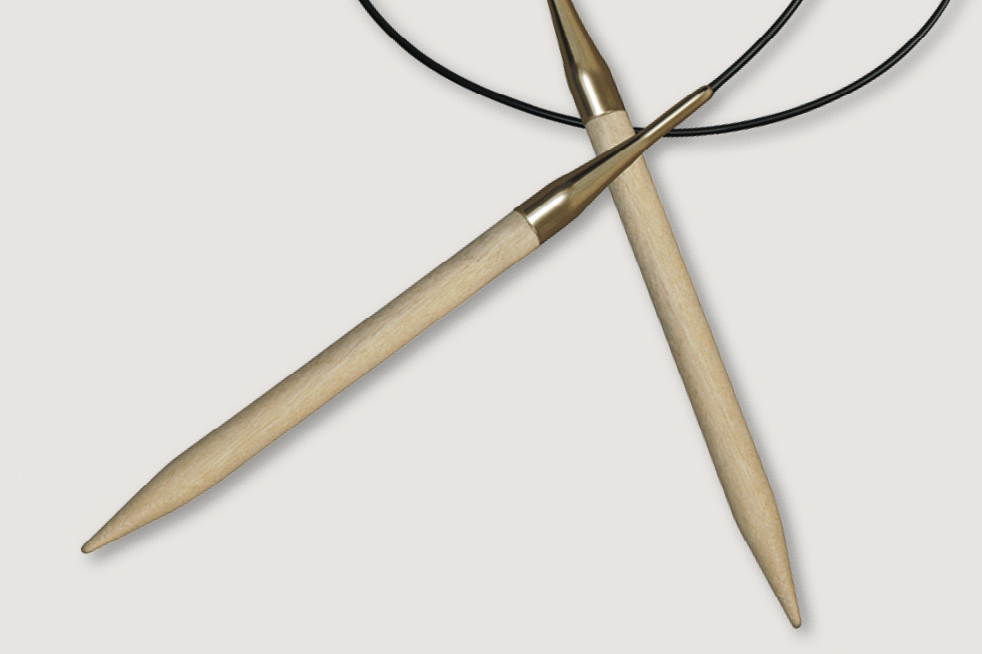
Step 3
Pick a knitting method
There are three main ways to knit in the stranded style.
1. With both yarns in the right hand, British style:
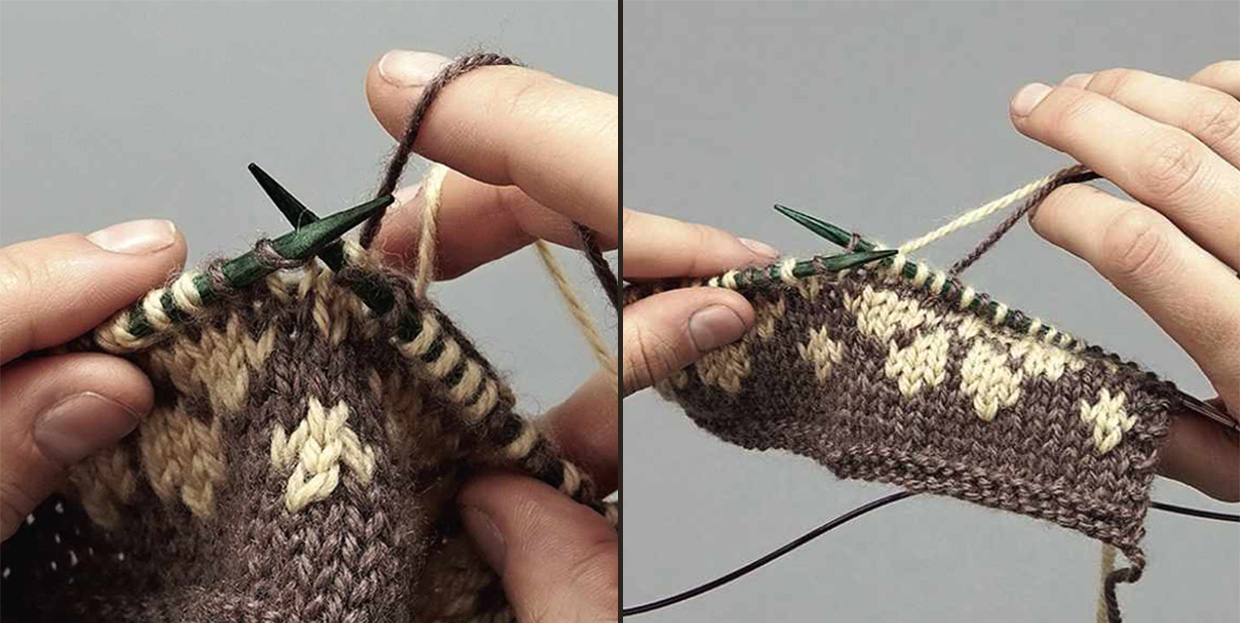
2. With both yarns in the left hand, Continental style:
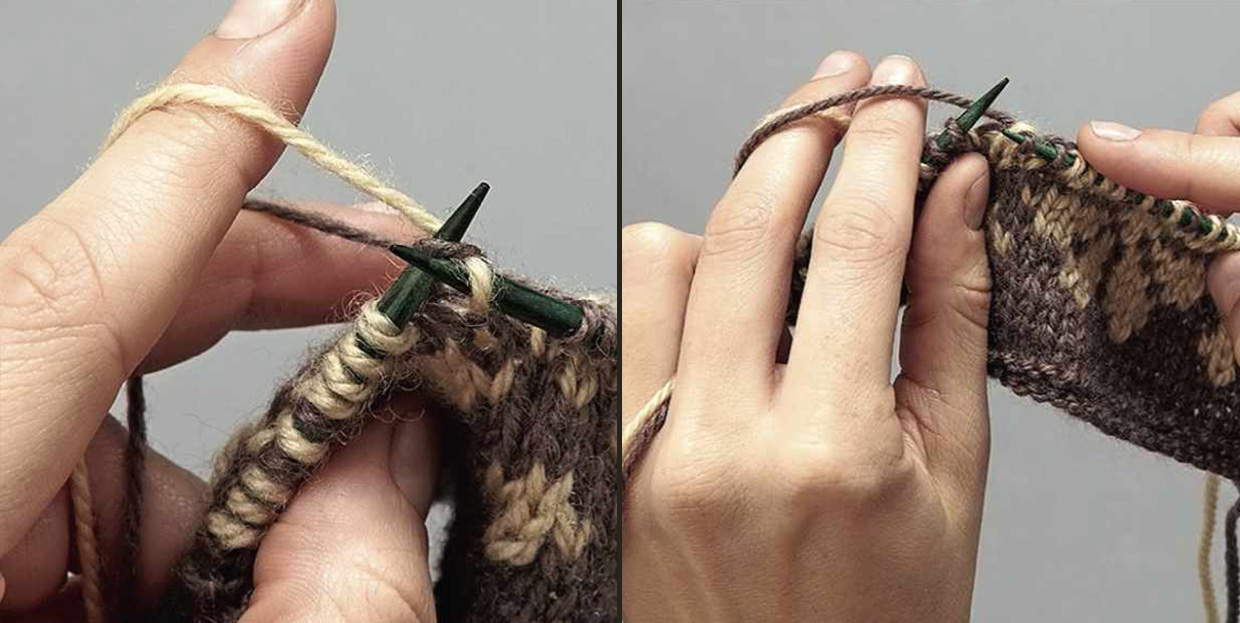
3. With one yarn held in each hand:
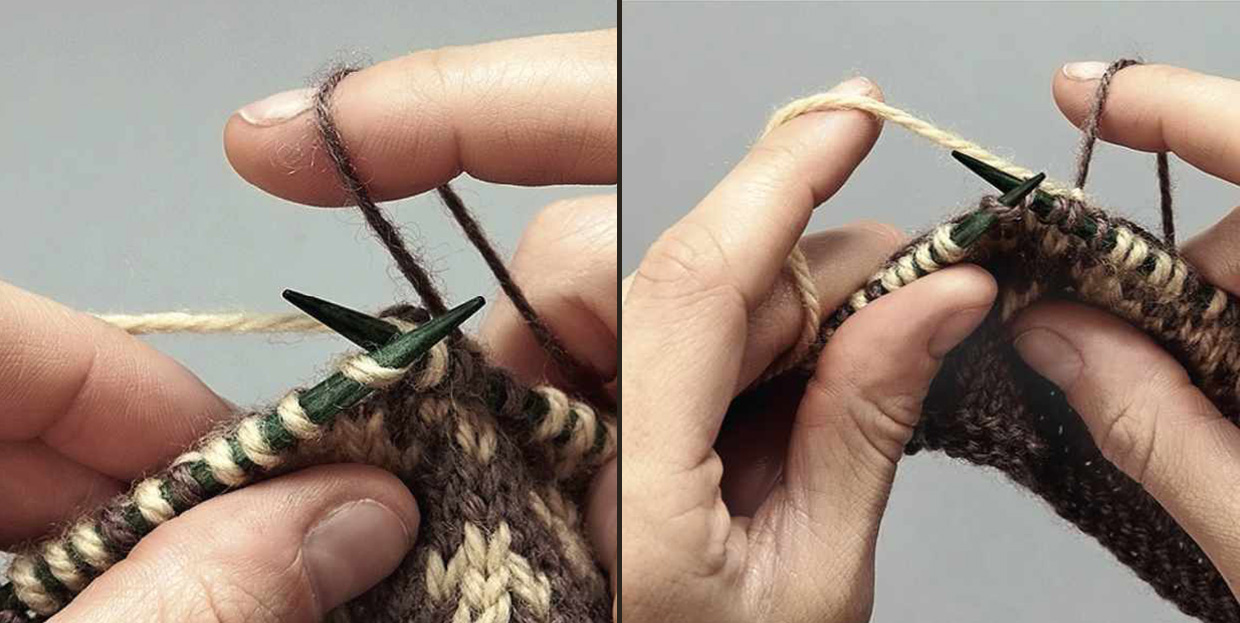
It’s worth trying all three methods and seeing which suits you. I’m normally a Continental knitter, so I hold my yarns in the left hand.
I switched from the British style because I was suffering from repetitive strain injury (RSI), but when I tried to knit some Fair Isle mittens Continental style I got in a right muddle!
So, for now, until I get more proficient at Continental style, I hold both yarns in my right hand, wrapped loosely around my right hand, using my right index finger to flick the correct yarn over the right hand needle.
I have previously worked with one yarn held in each hand, mixing the two styles of knitting, but I’m slower this way.
If you’re not sure which will suit you best, experiment before starting on a big project. If you switch part way through from one style to another you may unwittingly change your tension.
Step 4
Understand colour dominance
Holding your yarn consistently is also important because to get the best effect you need to hold the contrast colour yarn (CC) below the main colour yarn (MC) to make it ‘dominant’.
If there are an equal number of stitches in the two different colours throughout the pattern (for example, in a houndstooth or chequered pattern) then you’ll need to decide which yarn you want to stand out more, and hold that one below the second colour.
The MC yarn held above will travel a slightly longer distance between stitches than the CC yarn held below. This will make the stitches in the MC yarn shorter than the stitches in the CC, causing the CC stitches to stand out more.
You can see an example of this with our two-colour swatches below. The bottom row of flowers has been knitted correctly – the yellow yarn has been held below and so it is dominant and stands out against the brown background.
In the second row of flowers the yellow yarn has been held above – so it is no longer dominant and appears to recede very slightly into the brown background.
Whatever you do, don’t mix up which yarns you hold below or above within a row. This will chop and change which yarn is dominant and make your patterning look rather untidy. You can see this in the top row of yellow flowers.
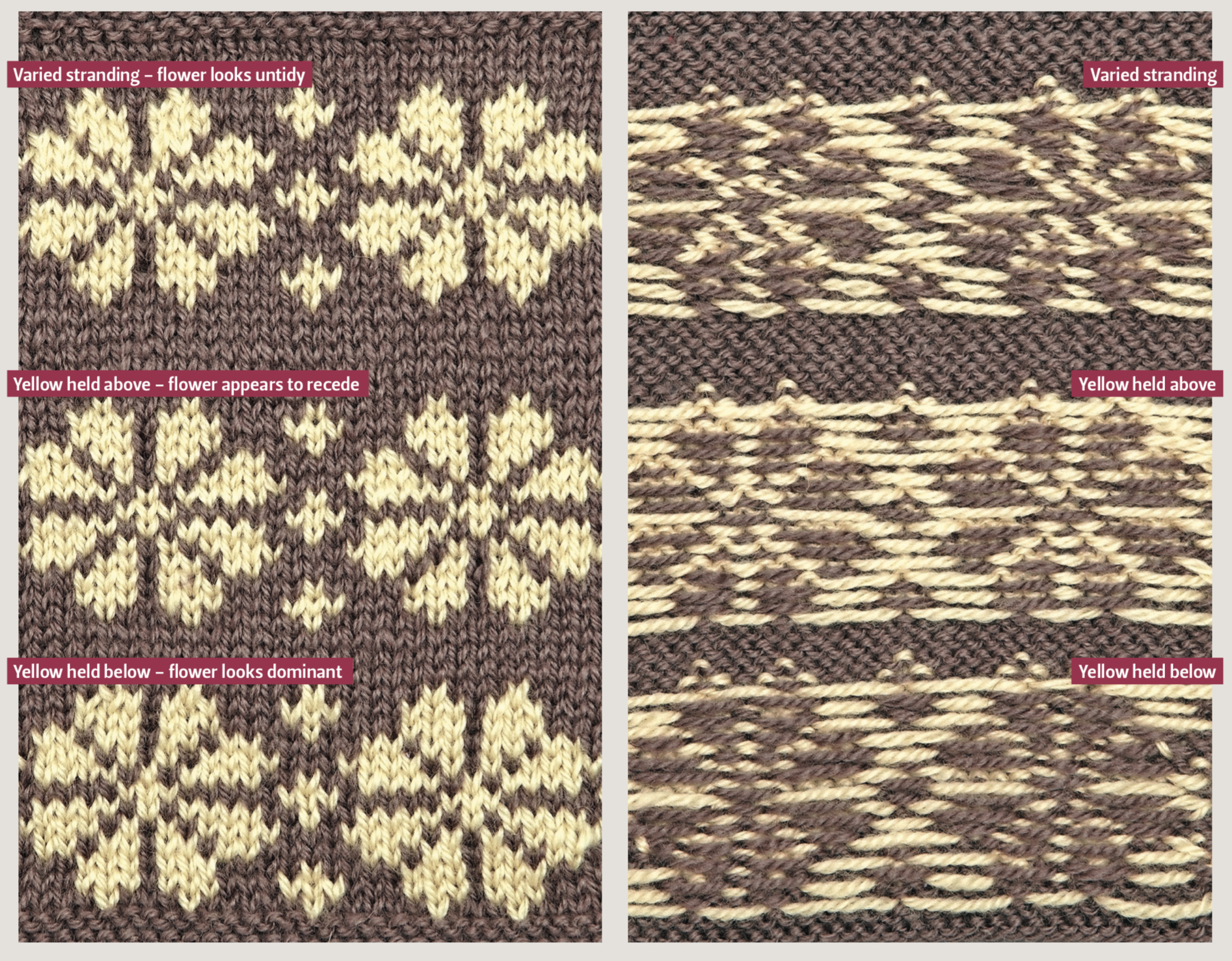
Step 5
If in doubt, swatch
It’s definitely worth swatching because, despite the fact that the bottom set of flowers is ‘correct’, I actually think in this case the middle row looks neater and nicer.
It’s also possible to tell what’s going on, or indeed going wrong, by looking at the back of your work. Again, looking at our swatch, you can see that the top row of flowers is a complete mess, while the two sets below are much neater.
The differences between the three rows of flowers may look subtle here, but over a large garment the dominant colour will stand out much more obviously.
If you’re working flat, take both yarns to the end of each row and twist them together. This will help prevent holes, but can still be a little messy.
For this reason alone it’s worth working stranded knitting in the round whenever possible. It’s also much easier to see what’s going on, and know what colour to use for each stitch, if you’ve always got the right side of the work facing you.
If you’ve stranded your colours correctly you should actually be able to see a kind of ‘negative’ of the pattern you’re creating on the wrong side of the work.
Step 6
Learn how to strand the yarn
Once you’ve decided which style of stranding you’re going to do, and which yarn should be dominant, you need to decide how you’re going to strand your two colours. Although ‘true’ Fair Isle knitting should have no more than six stitches between colour changes, Scandinavian-style colourwork can have much bigger gaps.
When there are only a few stitches of each colour it’s fine to just switch between the colours, stranding the one not in use loosely across the back.
However, if there are a large number of stitches between colour changes you may want to twist the yarns over each other every now and then. This will secure the yarn not in use at the back of the work, preventing large loops and helping to keep the tension more even.
Not all knitters need to do this and it’s worthwhile swatching to see what technique suits your knitting style.
If you’re twisting your yarns together a lot, you may notice the contrast colour start to show up through the background yarn. This is known as ‘grinning’ and isn’t usually a desirable effect. To avoid it, try twisting your yarns together a little less.
Start with a small project, swatch lots and you’ll soon get the hang of it! For more help, see the detailed instructions in our tutorial on how to catch Fair Isle floats.
Step 7
Keep your ribbing neat
If working corrugated ribbing, knit the entire first round in the main colour and then join in the contrast colour purl stitches in the second round. This will prevent a visible colour change on the first round of the purl stitches.
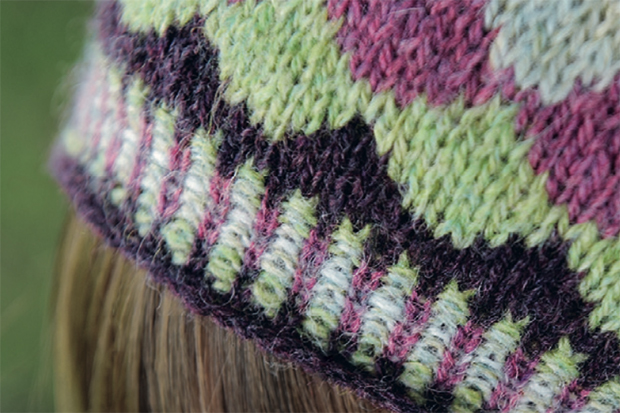
Step 8
Do the twist when working flat
If working stranded colourwork flat, take both yarns to the end of the row and twist the two colours together at the end – this gives the neatest finish, although you’ll probably still need a little duplicate stitching here and there.

Step 9
Knit small circumferences inside out
It can be hard to control tension when working stranded colourwork in small circumferences (for example, the thumb of a mitten).
To avoid pulling one colour more tightly than the other, turn your knitting inside out before you work (you’ll be knitting at the back rather than the front of the work facing you) – this will stretch the loops of unworked yarn more evenly across the wrong side of the work.
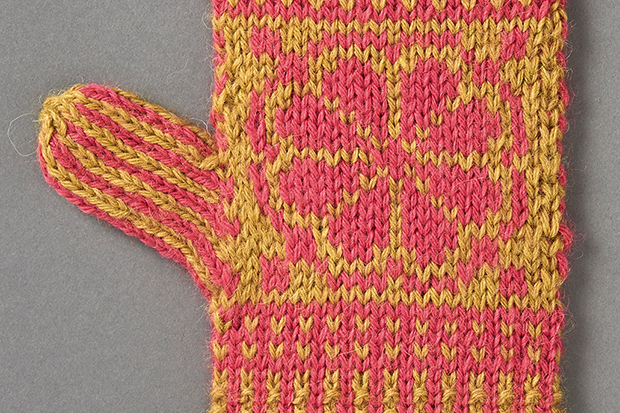
Step 10
Weave in ends as you go
Weave in your ends as you go or, if you’re working with a sticky, Shetland-style wool, leave cut ends about 10cm long at the end of rounds when joining in new colours. Use these later to duplicate-stitch any messy sections or mistakes.
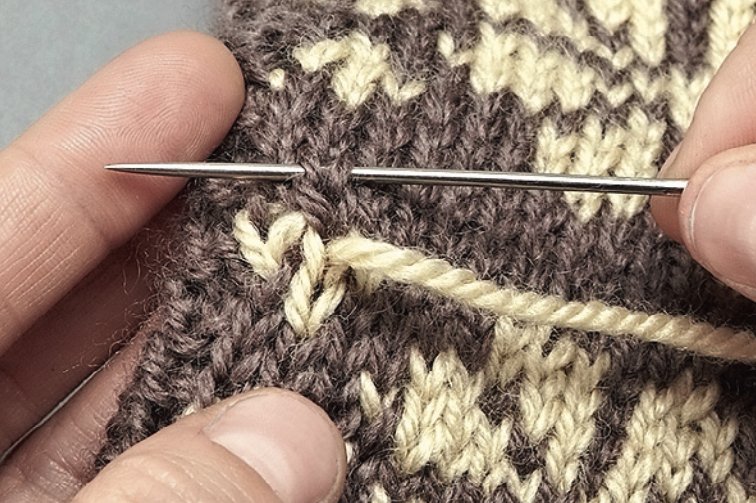
Step 11
Blocking is best
Always block stranded colourwork made with traditional yarns. This will really blend the colours together where they join and give a lovely finish.
Be careful not to roll up too tightly if using the ‘Swiss roll’ method to squeeze out the water – this can flatten the fibres too much and take some of the bounce out of the fabric.
Learn how to block knitting projects with our essential guide.











